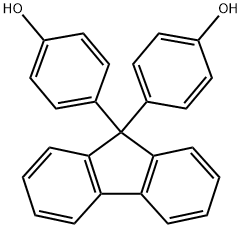Bisphenoxyethanolfluorene
- CAS NO.:117344-32-8
- Empirical Formula: C29H26O4
- Molecular Weight: 438.51
- MDL number: MFCD00216628
- EINECS: 672-704-1
- SAFETY DATA SHEET (SDS)
- Update Date: 2024-11-19 23:02:33

What is Bisphenoxyethanolfluorene?
Chemical properties
White powder
The Uses of Bisphenoxyethanolfluorene
4,4′-(9-Fluorenylidene)bis(2-phenoxyethanol) may be used for the following syntheses:
- poly-(carbotetramethyldisiloxane)s, containing poly[oxy{4,4′-(9-fluorenylidene)bis(2-phenoxyethylene)}oxytetramethyldisiloxane] (a fluorescent aromatic chromophore group)
- poly[oxy(arylene)oxy(tetramethyldisilylene)]s, containing fluorescent aromatic chromophore groups in the polymer main chain, via melt copolymerization reaction with 1,2-bis(diethylamino)tetramethyldisilane
General Description
4,4′-(9-Fluorenylidene)bis(2-phenoxyethanol) is an aryldiol.
Properties of Bisphenoxyethanolfluorene
| Melting point: | 117-120 °C(lit.) |
| Boiling point: | 610.7±55.0 °C(Predicted) |
| Density | 1.248±0.06 g/cm3(Predicted) |
| storage temp. | 2-8°C |
| Water Solubility | Insoluble in water |
| form | powder to crystal |
| pka | 13.95±0.10(Predicted) |
| color | White to Almost white |
| CAS DataBase Reference | 117344-32-8(CAS DataBase Reference) |
Safety information for Bisphenoxyethanolfluorene
| Signal word | Warning |
| Pictogram(s) |
 Exclamation Mark Irritant GHS07 |
| GHS Hazard Statements |
H302:Acute toxicity,oral H315:Skin corrosion/irritation H319:Serious eye damage/eye irritation H335:Specific target organ toxicity, single exposure;Respiratory tract irritation |
| Precautionary Statement Codes |
P261:Avoid breathing dust/fume/gas/mist/vapours/spray. P270:Do not eat, drink or smoke when using this product. P271:Use only outdoors or in a well-ventilated area. P280:Wear protective gloves/protective clothing/eye protection/face protection. P312:Call a POISON CENTER or doctor/physician if you feel unwell. P330:Rinse mouth. P302+P352:IF ON SKIN: wash with plenty of soap and water. P304+P340:IF INHALED: Remove victim to fresh air and Keep at rest in a position comfortable for breathing. P305+P351+P338:IF IN EYES: Rinse cautiously with water for several minutes. Remove contact lenses, if present and easy to do. Continuerinsing. P403+P233:Store in a well-ventilated place. Keep container tightly closed. |
Computed Descriptors for Bisphenoxyethanolfluorene
New Products
(S)-3-Aminobutanenitrile hydrochloride 4-Methylphenylacetic acid N-Boc-D-alaninol N-BOC-D/L-ALANINOL Tert-butyl bis(2-chloroethyl)carbamate 3-Morpholino-1-(4-nitrophenyl)-5,6-dihydropyridin- 2(1H)-one Furan-2,5-Dicarboxylic Acid Tropic acid 1-Bromo-3,5-Di-Tert-Butylbenzene S-2-CHLORO PROPIONIC ACID ETHYL ISOCYANOACETATE 2-Bromo-1,3-Bis(Dimethylamino)Trimethinium Hexafluorophosphate 4-IODO BENZOIC ACID 3-NITRO-2-METHYL ANILINE 1-(2,4-DICHLOROPHENYL) ETHANAMINE (2-Hydroxyphenyl)acetonitrile 4-Bromopyrazole 2-(Cyanocyclohexyl)acetic acid 4-methoxy-3,5-dinitropyridine 1-(4-(aminomethyl)benzyl)urea hydrochloride 2-aminopropyl benzoate hydrochloride diethyl 2-(2-((tertbutoxycarbonyl)amino) ethyl)malonate tert-butyl 4- (ureidomethyl)benzylcarbamate Ethyl-2-chloro((4-methoxyphenyl)hydrazono)acetateRelated products of tetrahydrofuran

![9,9-Bis[4-(2-acryloyloxyethyloxy)phenyl]fluorene](https://img.chemicalbook.in/CAS/GIF/161182-73-6.gif)

![2,2'-[9H-Fluoren-9-ylidenebis(4,1-phenyleneoxymethylene)]bis-oxirane](https://img.chemicalbook.in/CAS/GIF/47758-37-2.gif)




You may like
-
 Bisphenoxyethanolfluorene 95% CAS 117344-32-8View Details
Bisphenoxyethanolfluorene 95% CAS 117344-32-8View Details
117344-32-8 -
![9,9-Bis[4-(2-hydroxyethoxy)phenyl]fluorene CAS 117344-32-8](https://img.chemicalbook.in//Content/image/CP5.jpg) 9,9-Bis[4-(2-hydroxyethoxy)phenyl]fluorene CAS 117344-32-8View Details
9,9-Bis[4-(2-hydroxyethoxy)phenyl]fluorene CAS 117344-32-8View Details
117344-32-8 -
 1975-50-4 98%View Details
1975-50-4 98%View Details
1975-50-4 -
 2-HYDROXY BENZYL ALCOHOL 98%View Details
2-HYDROXY BENZYL ALCOHOL 98%View Details
90-01-7 -
 2-Chloro-1,3-Bis(Dimethylamino)Trimethinium Hexafluorophosphate 221615-75-4 98%View Details
2-Chloro-1,3-Bis(Dimethylamino)Trimethinium Hexafluorophosphate 221615-75-4 98%View Details
221615-75-4 -
 61397-56-6 CIS BROMO BENZOATE 98%View Details
61397-56-6 CIS BROMO BENZOATE 98%View Details
61397-56-6 -
 14714-50-2 (2-Hydroxyphenyl)acetonitrile 98+View Details
14714-50-2 (2-Hydroxyphenyl)acetonitrile 98+View Details
14714-50-2 -
 118753-70-1 98+View Details
118753-70-1 98+View Details
118753-70-1
Statement: All products displayed on this website are only used for non medical purposes such as industrial applications or scientific research, and cannot be used for clinical diagnosis or treatment of humans or animals. They are not medicinal or edible.